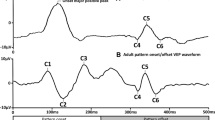Abstract
The value of recording visual evoked potentials in the investigation of homonymous visual field defects has been well recognized1–3, These original papers described the responses to unpatterned flash stimuli, but from the experimental work of Hubel and Wiesel4,5 we have come to understand that the occipital cortex responds maximally to linear gratings. Pattern evoked potentials have subsequently been shown to be more reproducible and of greater value hi assessing visual function. The clinical value of recording the evoked potentials from patterned stimuli in patients with homonymous field defects has recently been reported6,7.
Access this chapter
Tax calculation will be finalised at checkout
Purchases are for personal use only
Preview
Unable to display preview. Download preview PDF.
Similar content being viewed by others
References
L Vaughan, H. G., Katzman, R. and Taylor, J. (1963). Alterations of visual evoked response in the presence of homonymous hemianopia. Electroenceph. Clin. NeurophysioL, 15, 737
Vaughan, H. G. and Katzman, R. (1964). Evoked response in visual disorders. Ann. NY Acad. Sci., 112, 305
Kooi, K. A., Guvener, A. M. and Bagegu, B. K. (1965). Visual evoked responses in lesions of the higher visual pathways. Neurology, 15, 841
Hubel, D. H. and Wiesel, T. N. (1959). Receptive fields of single neurones in the cat’s striate cortex. J. Physiol (Lond), 160, 106
Hubel, D. H. and Wiesel, T. N. (1962). Receptive fields binocular interaction and functional architecture in the cat’s visual cortex. J. Physiol. (Lond), 148, 574
Wildberger, H. G. H., van Lith, G. H. M., Winjgaarde, R. and Mak, G. T. M. (1976). Visually evoked cortical potentials in the evaluation of homonymous and bitemporal visual field defects. Br. J. Ophthal, 60, 272
Blumhardt, L. D., Barrett, G. and Halliday, A. M. (1977). The asymmetrical evoked potential to pattern reversal in one half field and its significance for the analysis of visual field defects. Br. J. Ophthal, 61, 454
Jasper, H. H. (1958). Report of a committee on methods of clinical examination in electroencephalography. Electroenceph. Clin. Neurophysiol, 10, 370
Millodot, M. and Riggs, L. A. (1970). Refraction determined electrophysiologically. Arch. Ophthal NY, 84, 272
Spekreijse, H. (1966). Analysis of EEG responses to diffuse and patterned light in the human. (Thesis) D. W. Junk, The Hague.
Regan, D. (1972). Evoked potentials to changes in the chromatic contract and luminance contract of checkerboard stimulus patterns. Adv. Exp. Med. Biol, 24, 171
Michael, W. F. and Halliday, A. M. (1971). Differences between the occipital distribution of upper and lower field pattern-evoked responses in man. Brain Res., 32, 311
Harter, M. R. (1971). Visually evoked cortical responses to chequerboard patterns: Effect of check-size as a function of retinal eccentricity.Electroenceph. Clin. Neurophysiol, 28, 48
Harter, M. R. and White, C. T. (1968). Effects of contour sharpness and check size on visually evoked cortical potentials. Vision Res., 8, 701
Editor information
Editors and Affiliations
Rights and permissions
Copyright information
© 1980 MTP Press Limited
About this chapter
Cite this chapter
Howe, J.W., Mitchell, K.W. (1980). Visual evoked potentials from quadrantic field stimulation in the investigation of homonymous field defects. In: Barber, C. (eds) Evoked Potentials. Springer, Dordrecht. https://doi.org/10.1007/978-94-011-6645-4_30
Download citation
DOI: https://doi.org/10.1007/978-94-011-6645-4_30
Publisher Name: Springer, Dordrecht
Print ISBN: 978-94-011-6647-8
Online ISBN: 978-94-011-6645-4
eBook Packages: Springer Book Archive




